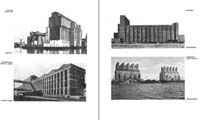Grain elevators led double life in shaping modern architecture
LAWRENCE – They dot the skyline of countless small towns throughout the Midwest, hulking cement towers often visible for miles. New research from a University of Kansas professor shows that grain elevators, those unassuming, utilitarian icons of the Midwest, have done far more than store grain. They have shaped the development of 20th century architecture and played a key role in the emergence of postmodern thinking.
 According to Dave Tell, associate professor of communication studies, grain elevators were once the symbol of modernity, but over time they came to be viewed as a liability to modern architecture, paving the way for postmodernity. Tell recently wrote a paper on the subject, “The Rise and Fall of Mechanical Rhetoric, or, What Grain Elevators Teach us About Postmodernity.” The paper is under review by the Quarterly Journal of Speech.
According to Dave Tell, associate professor of communication studies, grain elevators were once the symbol of modernity, but over time they came to be viewed as a liability to modern architecture, paving the way for postmodernity. Tell recently wrote a paper on the subject, “The Rise and Fall of Mechanical Rhetoric, or, What Grain Elevators Teach us About Postmodernity.” The paper is under review by the Quarterly Journal of Speech.
Tell’s research begins in 1911 with German architect Walter Gropius’ interest in the architectural possibilities of reinforced concrete. In 1913, Gropius wrote an article that was illustrated with nine photographs of concrete grain elevators.
After the publication of Gropius’ article, the great French architect Le Corbusier became smitten by Gropius’s grain elevators, so much so that he reprinted them in his 1923 manifesto, “Toward an Architecture.” But before doing so, Le Corbusier had retouched the photographs with a paint known as gouache, essentially an early 20th century version of “photoshopping.”
The grain elevator photographs went ‘viral’ and were reprinted dozens of times in at least six different countries over a 100-year span. By the late 1920s, the grain elevator photographs were considered icons of modernity.
“At the peak of their influence, in 1969, Yale University’s Vincent Scully even used a doctored Le Corbusier grain elevator photograph to explain why Frank Lloyd Wright could be considered a modern architect,” Tell said.
Soon after, however, the intellectual cachet of grain elevators would fall.
First, a 1971 Harvard dissertation printed the Gropius and Le Corbusier versions of a grain elevator on the same page. With the photos next to each other, Le Corbusier’s fabrication was obvious.
To emphasize grain elevators’ appeal of function over aesthetics, Le Corbusier had removed signs of ornamentation in Gropius’ photographs and created the illusion of straight lines and hard angles. Once an icon of modernity, the grain elevator photograph now appeared to be the product of manipulation.
The discovery came at time when the field of rhetoric was being transformed from the study of public speaking to the study of symbolism.
“The Harvard dissertation demonstrated that the doctored grain elevator photographs were covered with gouache, which made them lousy symbols because they didn’t correspond with any actual grain elevators in the world,” Tell said.
To the great minds of the 1970s, the now fraudulent grain elevator photographs — once icons of modernity — suddenly appeared as evidence that modern architecture was misguided and that a new style of architecture was needed, as was a new way of thinking.
Charles Jencks, a theorist who studied the intersection of rhetoric and architecture, had just the name for such an enterprise. He called it “Post-Modernism” and explained the new term by borrowing from a rhetoric textbook and critiquing Le Corbusier’s grain elevators. Two other theorists, Robert Venturi and Fredric Jameson, were less dramatic, but they, too, announced the advent of postmodernity by critiquing Le Corbusier’s grain elevators.
“These three theorists, each working independently, used grain elevators as a way to announce the dawning of postmodernity,” Tell said. “Simply by following the re-publication of these photographs, you can learn really interesting things about what was modernity and what was postmodernity. And why postmodernity seemed relevant, even urgent, in the early 1970s.”